Hallux rigidus—a form of degenerative arthritis in the big toe joint—can make walking, running, or even standing a painful experience. If you suffer from this condition, the right footwear is essential. Supportive shoes can help reduce joint strain, minimize pain, and allow for more natural movement. Whether you’re looking for athletic shoes, everyday walkers, or dress options, our expert-curated list highlights the best shoes that relieve hallux rigidus symptoms while offering style and function. Each pick includes specialized features like stiff soles, rocker bottoms, and wide toe boxes to support your step without aggravating the joint.
Best Shoes for Hallux Rigidus – Summary Table
Shoe Name (click to scroll to review) | Best For | How It Helps | Gender | Price |
|---|---|---|---|---|
Max cushion walking | Rocker bottom eases big toe pressure | Men/Women | ||
All-day support | Stiff sole + motion control | Men/Women | ||
Diabetics & sensitive feet | Orthotic insole + roomy toe box | Men | ||
Trail & casual | Zero-drop + wide toe box | Men/Women | ||
Business casual | Rocker sole + arch support | Women | ||
Stability walking | Rigid sole + rollbar for support | Men/Women | ||
City walking and daily errands | Rocker sole reduces big toe flexion; firm midsole supports stable, pain-free steps | Men/Women |
HOKA Bondi 9
Best for: Maximum cushioning and rocker support
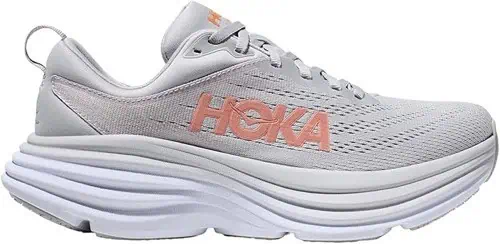
The HOKA Bondi 9 continues to lead as one of the best shoes for hallux rigidus sufferers. It features a thick EVA midsole and signature Meta-Rocker design, which helps minimize toe bend and propels the foot forward without engaging the big toe joint excessively. The plush cushioning and wide base provide unmatched stability, ideal for people with arthritic conditions or joint pain. In this 9th iteration, the Bondi also adds a more durable upper with zonal engineered mesh, improving breathability and lockdown.
Those with hallux rigidus often need rigid soles to limit toe flexion—but not all stiff soles feel comfortable. The Bondi 9 strikes the right balance, offering both protection and plushness. While it’s not suited for formal settings, it’s an outstanding daily walking or recovery shoe. Consider sizing up if you need room for orthotics or toe spacers.
Specs:
- Meta-Rocker geometry
- EVA foam midsole
- Engineered mesh upper
- Weight: ~10.8 oz (women’s), ~11.9 oz (men’s)
Pros:
- Rocker sole reduces toe flexion
- Excellent cushioning for arthritic joints
- Wide base for stability
Cons:
- Pricey
- Bulky look may not appeal to all
Men’s version | Women’s version
Brooks Addiction Walker 3
Best for: All-day support and motion control
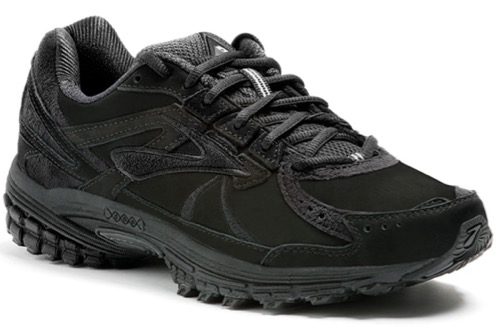
The Brooks Addiction Walker 3 is a stability powerhouse that’s ideal for people with hallux rigidus who need firm control, cushioned support, and long-lasting comfort. Built on a motion control platform, this shoe limits overpronation and reduces stress on the forefoot, including the big toe joint. The latest version features an updated leather upper with a more modern profile and improved breathability while maintaining its reputation for rugged durability.
What makes it especially helpful for hallux rigidus is its Extended Progressive Diagonal Rollbar (PDRB), which guides your foot into proper alignment and limits excess motion. The outsole is also certified for slip-resistance, making it a good pick for healthcare workers, retail employees, and anyone on their feet for hours. While it leans heavier than most running shoes, that weight adds structure, which hallux rigidus sufferers often need to control motion and relieve toe pain. It’s also Medicare-approved for diabetic foot care, making it an excellent choice for people with multiple foot health concerns.
Specs:
- Full-grain leather upper (or suede, depending on model)
- PDRB support system
- Slip-resistant (SATRA-certified)
- Weight: ~14.5 oz (men’s), ~12.9 oz (women’s)
Pros:
- Excellent arch and motion control
- Slip-resistant for work environments
- Very durable and stable
Cons:
- Heavier than other walking shoes
- Limited color/style options
Men’s version | Women’s version
Orthofeet Edgewater Stretch
Best for: Diabetics and sensitive feet with hallux rigidus
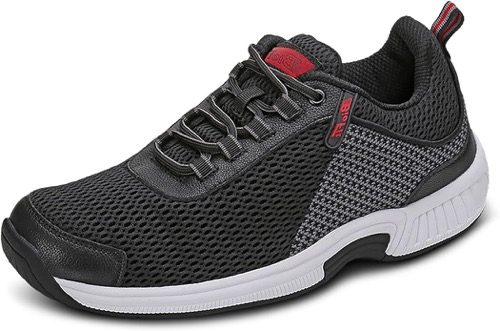
The Orthofeet Edgewater Stretch is designed specifically for people dealing with multiple foot issues—hallux rigidus, bunions, diabetes, and neuropathy. Its standout feature is the stretchable upper, which eliminates pressure on sensitive areas while adapting to swelling or foot shape irregularities. It’s one of the most customizable orthopedic shoes available, making it a top choice for individuals who can’t tolerate rigid, off-the-shelf models.
The anatomical orthotic insole and built-in arch support reduce pressure on the forefoot, easing pain in the big toe joint. The mild rocker bottom helps roll the foot forward, compensating for limited toe movement due to stiffness or arthritis. It also includes multiple spacers to adjust volume inside the shoe and a roomy toe box to prevent irritation or rubbing. For people who need a shoe that accommodates orthotics or swelling—and want pain relief with every step—Edgewater Stretch is a top performer.
While it’s not stylish or athletic-looking, it’s ideal for home use, errands, or anyone prioritizing comfort and pain reduction. Many users report significant improvement in both toe and heel pain over weeks of use.
Specs:
- Stretch knit upper
- Removable orthotic insole
- Mild rocker sole
- Weight: ~11 oz
Pros:
- Accommodates swelling and deformities
- Excellent arch support and cushioning
- Comes with spacers for fit adjustment
Cons:
- Looks orthopedic
- Limited outdoor/weather protection
Men’s version | Women’s version
Altra Olympus 6
Best for: Trail walking and everyday wear with a wide toe box

The Altra Olympus 6 is a trail running shoe that’s become a surprising favorite for people with hallux rigidus—especially those who prioritize natural foot movement, cushioning, and toe space. This model features Altra’s signature FootShape™ toe box, which allows the forefoot to splay naturally without compressing the big toe. That extra room can reduce joint pressure and accommodate orthotics, toe spacers, or swelling caused by arthritis.
It also features a thick, shock-absorbing midsole with a zero-drop platform, meaning your heel and forefoot sit at the same level. For those with hallux rigidus, this can promote more balanced walking mechanics while decreasing strain on the first metatarsophalangeal joint. The Vibram® Megagrip outsole adds traction and durability, making this a strong option for those who want to hike, walk long distances, or need extra grip in slippery conditions.
While the Olympus 6 is a trail shoe, it works well for city use, casual wear, and fitness walking. It may take time to adjust to the zero-drop design if you’re used to traditional heels, but for many, the trade-off is a roomier, more comfortable stride.
Specs:
- Wide toe box
- 33 mm stack height, zero-drop
- Vibram® Megagrip outsole
- Weight: ~12 oz (men’s), ~9.6 oz (women’s)
Pros:
- Extremely roomy forefoot
- Grippy, stable sole
- Cushioned ride with zero drop for alignment
Cons:
- May require transition time
- Not formal or discreet in appearance
Men’s version | Women’s version
Dansko Walker
Best for: Business casual comfort with rocker motion support
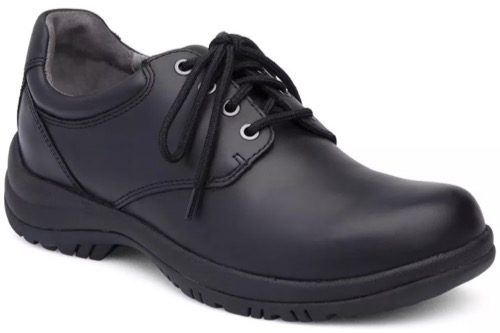
The Dansko Walker is a top pick for people with hallux rigidus who need a shoe that blends comfort, orthopedic function, and a polished look suitable for work. Built with a rocker bottom sole and a firm, supportive midsole, it helps reduce pressure on the big toe joint by encouraging forward propulsion without requiring full toe flexion. This makes walking easier and less painful for those with limited mobility in the toe.
Unlike many orthopedic shoes, the Dansko Walker doesn’t look overly clinical. Its full-grain leather upper, sleek profile, and slip-resistant outsole make it perfect for work environments or semi-formal occasions. Inside, the cushioned footbed includes arch support and shock absorption, while the roomy toe box accommodates foot swelling or custom orthotics. It’s a practical choice for professionals, teachers, retail workers, and others who are on their feet all day but still need a shoe that fits a business casual dress code.
While it doesn’t offer the sporty flexibility of athletic models, it excels in durability, structure, and long-term comfort. Note: the women’s version is often easier to find than the men’s.
Specs:
- Rocker bottom outsole
- Full-grain leather upper
- Removable triple-density footbed
- Weight: ~12.5 oz (women’s)
Pros:
- Professional appearance
- Rocker sole reduces forefoot pressure
- Great arch and heel support
Cons:
- Slightly stiff until broken in
- Not ideal for very wide feet
Women’s version | Men’s version
New Balance 928v3
Best for: Stability walking and motion control with a firm sole
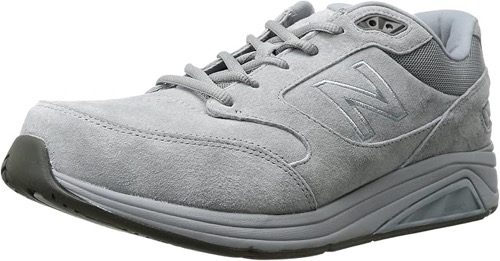
The New Balance 928v3 is a go-to choice for individuals with hallux rigidus who need dependable support, excellent motion control, and reduced forefoot stress. This latest version continues the legacy of the 928 series, offering a firm, durable sole that limits big toe joint motion—key for minimizing arthritis-related pain.
Its standout feature is the ROLLBAR® stability system, which prevents excessive rearfoot movement and promotes a smooth heel-to-toe transition without forcing flexion at the forefoot. Combined with a firm, supportive midsole and a removable PU insole, it works well for orthotics and toe spacers. The shoe also has an extra-wide toe box option, which is critical for those who experience inflammation or swelling in the big toe area.
The 928v3 is Medicare-approved (A5500) for diabetic use and built for all-day comfort. While not flashy, it’s especially helpful for people walking on hard surfaces, working on their feet, or requiring a stable foundation due to other biomechanical issues. It’s available in multiple widths and leather or mesh uppers, making it one of the most versatile therapeutic walking shoes available.
Specs:
- ROLLBAR® motion control system
- Removable polyurethane insert
- Full-grain leather or mesh upper
- Weight: ~15 oz (men’s), ~13.5 oz (women’s)
Pros:
- Excellent stability and motion control
- Available in wide/extra-wide sizes
- Durable and orthotic-friendly
Cons:
- Heavier than average
- Style is conservative
Men’s version | Women’s version
HOKA Transport
Best for: Urban walking and all-day comfort with mild rocker support
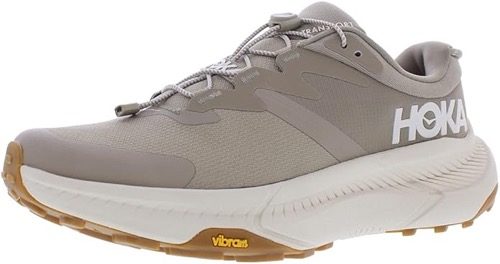
The HOKA Transport is a commuter-friendly walking shoe that also offers surprising benefits for people with hallux rigidus. Though not as maximalist as the Bondi line, the Transport features HOKA’s signature rocker sole and firm midsole foam that together help reduce dorsiflexion at the big toe joint. This allows the wearer to roll through the gait cycle smoothly—without stressing the stiff or arthritic toe.
What sets the Transport apart for urban walkers is its lightweight design, recycled materials, and thoughtful commuter features like 360° reflectivity and a quick-toggle lace system. The ride is stable and cushioned but not overly soft, which is helpful for hallux rigidus patients who need a firm base. The shoe’s stiffness under the forefoot limits unwanted toe flexion, offering a more pain-free stride over longer distances.
The HOKA Transport is ideal for city dwellers, nurses, teachers, or anyone who needs all-day support without a clunky profile. It also fits in better with casual or even smart-casual outfits than most athletic walking shoes. While it’s not a medical-grade orthopedic shoe, its rockered geometry and firm structure make it a viable option for mild to moderate hallux rigidus.
Specs:
- Early-stage Meta-Rocker sole
- Compression-molded EVA midsole
- Quick-toggle lace system (removable for traditional laces)
- Weight: ~8.9 oz (women’s), ~10.1 oz (men’s)
Pros:
- Rocker design eases forefoot pressure
- Lightweight and sleek for a HOKA
- Reflective accents and commuter-friendly design
Cons:
- Less cushion than Bondi
- Narrower toe box than Altra or Orthofeet
Men’s version | Women’s version
How to Buy Shoes for People with Hallux Rigidus
Hallux rigidus, or stiff big toe, is a degenerative joint condition that can make walking painful and mobility difficult. Finding the right pair of shoes is one of the most important ways to manage symptoms and improve daily comfort. Whether you’re shopping for yourself or someone you care about, here’s what you need to know.
Hallux rigidus is arthritis of the big toe joint (the first metatarsophalangeal joint). It causes stiffness, swelling, and reduced motion, especially during walking or running. Poor footwear can worsen the condition, while the right shoes can reduce pain and limit joint deterioration.
What to Look for in Shoes
Choosing the right shoe features is crucial for protecting the affected joint. Focus on function over fashion—though many shoes today offer both.
Rigid Sole
A stiff or non-flexing sole helps prevent the big toe from bending during walking. This reduces pain and protects the joint from further wear. Shoes should bend minimally at the forefoot.
Rocker Bottom Design
A curved sole can help the foot roll through the walking motion, relieving pressure from the toe joint. This design minimizes the need for toe extension during each step.
Wide Toe Box
The shoe’s front should offer enough room to allow natural toe splay and accommodate any swelling. Narrow or pointed shoes can worsen pain and increase stiffness.
Low Heel Drop
High heels or shoes with elevated heel-to-toe slopes can increase pressure on the forefoot. Look for shoes with a low or neutral heel drop to reduce toe strain.
Arch and Midfoot Support
Proper arch support distributes body weight evenly and prevents overloading the toe joint. A firm, supportive midsole can also reduce pressure and improve gait alignment.
Removable Insoles
Shoes with removable insoles are ideal for inserting custom orthotics or stiffening plates. These additions help limit toe movement and support overall foot biomechanics.
Lightweight and Shock-Absorbing
Footwear should be cushioned enough to absorb impact without adding excess weight. Lighter shoes are easier on the joints, especially during long wear times.
Avoid These Shoe Features
Certain design choices can aggravate hallux rigidus and should be avoided when shopping.
- Thin, flexible soles – These increase big toe flexion, worsening pain.
- Pointed toe boxes – They compress the forefoot and restrict motion.
- High heels – They load the forefoot and stress the toe joint.
- Slip-on styles – Without laces or straps, these often lack structure and support.
Consider Shoe Modifications
If a shoe meets most—but not all—of your criteria, it may be possible to enhance it with accessories:
- Add a carbon fiber insole to reduce toe motion.
- Insert custom orthotics prescribed by a podiatrist.
- Use toe spacers to alleviate pressure from neighboring toes.
Proper fit matters just as much as design, as such:
Tips for Fitting and Shopping
- Shop later in the day when feet are slightly swollen.
- Try shoes on while wearing the socks or orthotics you’ll use regularly.
- Walk around with the shoes you select to ensure the toe joint remains stable and comfortable.
- If buying online, look for flexible return policies and sizing guidance.
Who Benefits from These Features
Shoes designed for hallux rigidus are not only beneficial for those with this specific condition. They also help people with the following conditions:
- Big toe joint arthritis
- Turf toe
- Post-operative recovery after toe joint surgery
- General forefoot pain
- Mobility limitations that require joint stabilization
Shoes for a Better Quality of Life
Buying the right shoes for someone with hallux rigidus can make a significant difference in their mobility and quality of life. By prioritizing stiffness, support, and comfort, you’ll reduce strain on the toe joint and promote healthier movement. While it might take time to find the perfect pair, focusing on the features listed above is the best place to start.